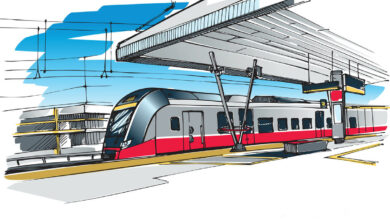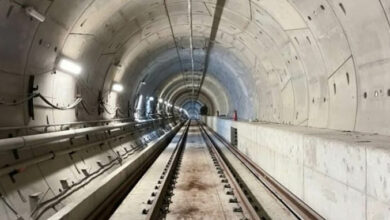“Construction is a viable career choice” – Steve Aquino

Across the country, during the 18-month pandemic, the construction industry remained operational. Contractors adapted and ensured best health and safety practices to keep their workers and projects going. The adaptation of working methods to the new pandemic reality, the lack of material, the delays in granting building permits, the difficulty in obtaining financing, are just some of the many problems that large construction companies had to face and overcome in order to stay in business.
Steven Aquino, Chief Executive Officer of Corebuild Construction, in this interview with Milénio Stadium, tells us how they have lived through this unprecedented time and gives us a clear idea of what it will take for construction to continue to be one of the main engines of the Canadian economy.
Milénio Stadium: The pandemic arrived a year and a half ago. To what extent has your company felt the impact of Covid-19?

Steven Aquino: The pandemic has impacted the company in countless ways. We were initially deemed essential on some of our projects and not others, which was a logistical challenge. Then we had all of the challenges of keeping our sites operating – ensuring that Covid-19 exposures were tracked, and staff was maintaining proper cleaning protocols and social distancing. As the day to day impacts of managing Covid became more normalized, we were stuck dealing with some of the unexpected issues – delivery issues and material shortages made it difficult to complete work, as well as sudden increases in pricing due to shortages. We also have dealt with long waiting periods for new projects to start – due to permit delays, slowing of investment due to covid concerns, government indecision etc.
MS: Have the constraints of this pandemic required a profound change in the workflow of your employees?
SA: We have had to learn how to keep the company operating with most of our staff at home. This was a drastic change in how we operate and continues to evolve on a daily basis. We have learned to use the numerous tools available for virtual meetings, conference calls, SharePoint files, etc., to improve our productivity during these challenging circumstances. As a business leader, it was difficult to remain connected with staff that I typically interact with in person on a daily basis. I have struggled to manage as effectively without those points of contact, but try and speak to staff on a regular basis via phone to maintain those connections. The pandemic has been difficult for all of our staff and their families, so we have tried to be as sensitive as possible to these impacts and tried to develop a plan for their work given various obstacles (elderly parents, pre-existing conditions, children at home).
MS: The construction industry was considered essential and therefore practically did not stop. But there was, at some point, a shortage of materials – did your company feel that? If so, do you still have to deal with it?
SA: We have had to deal with material shortages and delays. This has been a challenge throughout the pandemic, so we have tried various different strategies to cope. If possible, we searched out alternates, if they were more readily available and of similar cost. We installed temporary solutions when more complex items were delayed, such as hardware, finished metals and complicated glass. On some projects, we have altered our construction plans to utilize formwork systems that do not require as much lumber, due to the cost and scarcity issues we were facing. Construction is a fast-paced industry that requires constant attention and the ability to adapt quickly to changing market conditions.
MS: Another complaint that has been heard recurrently has to do with the increase in the price of materials, which consequently increases the final cost of the work. What justifies this increase?
SA: There are a number of factors that impact the cost of materials, in addition to those caused by the pandemic. Initially there were trade issues involving our largest trading partner in the U.S., and subsequent duties on lumber, aluminum and steel products – that have immediate impacts on the cost. As the pandemic started and economies temporarily closed, we dealt with supply chain issues and an inability to source what would normally be common materials. This drove up the demand and subsequently the cost of these items drastically – including masks, gloves, cleaning supplies etc. The issues surrounding the increase in cost of lumber are more nuanced, and have to do with low production capacity in the system, decreased availability of wood due to pests and environmental factors, as well as a shortage of labour in the manufacturing sector due to covid fears. All of these factors have driven up the cost drastically, but demand remained constant, so the price had to be paid in order to keep work moving. The increased costs in steel, drywall and insulation materials that we are seeing now appear to be more inflationary, as the construction market in the us soars, we have to pay higher costs for materials.
MS: There are many builders complaining about lack of personnel to work. In your opinion, why is this happening?
SA: There are a number of factors at play here. Generally speaking, the construction industry is very busy right now and demand for skilled trades is at the highest levels we have seen. This is coupled with an aging demographic that is starting to exit the industry and not as many younger works considering the construction trades as we would like. Our industry has faced the stigma in the past of being unsafe, too difficult physically or mentally, or less financially rewarding then other similar industries. I believe these factors are all not true, but we struggle to get this message out to younger individuals and new Canadians to attract them to construction. Our building trades unions have done extensive work in this area, and continue to try and open up construction opportunities to everyone, including women – who have been underutilized in the past, as well as visible minorities.
MS: In your opinion, have Canada, and Ontario in particular, adequately prepared for the natural aging of skilled construction workers by investing in training and upskilling of younger workers?
SA: This is a difficult question to answer. I believe that the trade Unions and other organizations have provided initial training to new workers, but our industry tends to develop staff through apprenticeship. We need the aging workers to train and develop the younger workers, as a lot of the experience they need is gained through actual work. I believe the industry is trying to respond to these pressures by rethinking how construction is completed and moving towards solutions such as modular construction or implementing more precast and premanufactured products into new projects, which will hopefully be less labour intensive. I do see trades such as masonry and stonework struggling as we are finding less new hires interested in the trade and projects are short staffed.
MS: We are in the middle of an election process – from what you know about the proposals of the various parties, what can Canadians expect from the future when it comes to the labour field?
SA: I believe all of the federal parties believe that new construction will be a catalyst for assisting the country in its economic recovery from the pandemic. It is our expectation that as some of the direct support programs for employees and individuals are closed, new investment will need to be made to help transition them to work. In addition to some of the major infrastructure projects slated in the transportation sector, as well as the ongoing growth in the residential sector should maintain a strong demand for workers in the future. Construction is a viable career choice for anyone interested in a skilled trade opportunity.
MS: What are the big challenges that the construction sector will face in the near future?
SA: In the near future, the industry will continue to face the challenges of operating through the pandemic – as new strains of the virus present new obstacles. Our utmost priority is keeping our staff and those on our projects safe. Beyond that, it will be dealing with the issues of inflation and material scarcity that will impact our projects in the short term. Long term – as I always tell my staff – construction companies most important asset is their people – finding, developing and helping this staff grow is the largest challenge our sector faces in competition with other industries.








Redes Sociais - Comentários